- Books Name
- A TEXT OF BIOLOGY - CLASS XII
- Publication
- ACME SMART PUBLICATION
- Course
- CBSE Class 12
- Subject
- Biology
Drugs and Alcohol Abuse
Surveys and statistics show that use of drugs and alcohol has been on the rise especially among the youth.
This is really a cause of concern as it could result in many harmful effects.
Proper education and guidance would enable youth to safeguard themselves against these dangerous behaviour patterns and follow healthy lifestyles.
The drugs, which are commonly abused are opioids, cannabinoids and coca alkaloids. Majority of these are obtained from flowering plants. Some are obtained from fungi.
Addictive Disorders
If the body needs continuous presence of psychoactive substance within it, it is called addiction.
Psychoactive drugs have the ability to alter the activity of nervous system.
Different psychoactive drugs along with their category and effects are given below.
Table : Major Categories of Psychoactive Drugs, their Effects and Clinical Uses
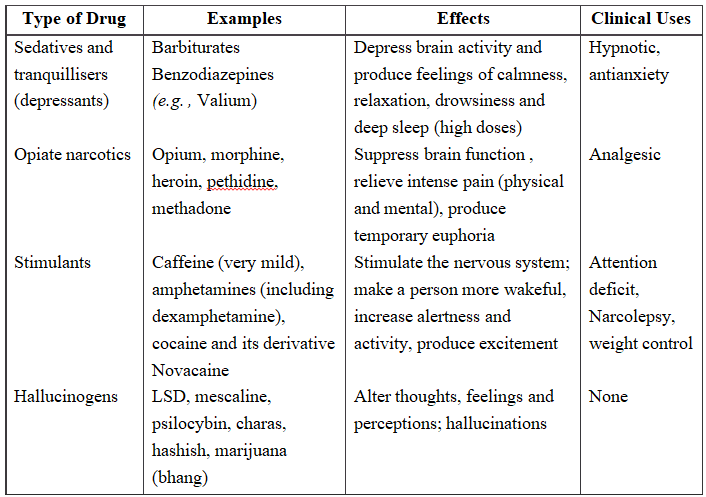
A person who is habitual user if abstains from a drug (abstinence), his body reacts i.e., ceases to function normally. It is called physical dependence.
The symptoms appearing in the body are withdrawal symptoms and range from mild tremors to convulsions, abdominal pain, diarrhoea, muscle cramps, all depending upon the type of drug abused.
In many cases the withdrawal symptoms may be life threatening and needs medical supervision.
1. Sedative-hypnotics :
Sedatives are the drugs that reduce excitement, assuage pain and lower the physiological or functional activity leading to drowsiness or sleep.
Hypnotics are also the drugs that induce sleep.
Sedative-hypnotics are more or less general CNS depressants and they include Barbiturates and Benzodiazepines.
Barbiturates and Benzodiazepines :
These are substituted derivatives of barbituric acid (a combination of melonic acid and urea; called malonyl urea) which are general depressants of all excitable cells but CNS is most sensitive to them.
They reduce anxiety and induce sleep. Repeated use of this causes to addiction.
It results in permanent damage to brain, headache, coma and muscular twitching.
Sudden withdrawal causes epilepsy.
2. Opiates (Opioid analgesics or Opiate narcotics) :
Opiates or opioids are derived from opium alongwith their synthetic relatives.
The drug that relieves pain by acting on CNS are termed as analgesic, they are also called pain killers.
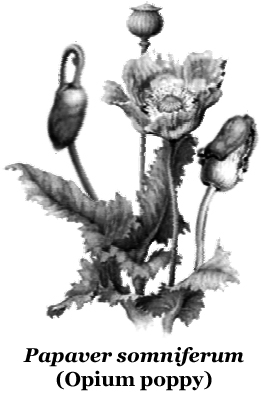
Opium is dried latex of unripe capsular fruits of poppy plant, Papaver somniferum (family; Papaveraceae).
It has heavy smell and bitter taste.
It is smoked or eaten.
Opioids bind to specific opioid receptors present in our CNS and gastrointestinal tract.
Opiates have narcotic, analgesic, sedative and astringent (that cause contraction of body parts) effects.
They slow down respiratory activity, cause constriction of pupil of eye, decrease glandular secretions, impair the digestion, produce nausea, vomiting and sterility.
Opium addicts lose weight, fertility and interest in work.
Opium contains a number of alkaloids :

(i) Morphine: Serturner, a pharmacist, isolated the active principal of opium in 1806 and named it 'morphine'. It is the main opium alkaloid, which is a strong analgesic and also has sedative and calming effect. Morphine depresses respiratory centre and contributes to the fall in SP. It can cause bradycardia (slow heart beat), release of ADH, reduction in urine output, constipation mild hyperglycaemia etc. It causes addiction. Diacetyl-morphine hydrochloride is brown sugar/smack and is more powerful analgesic than morphine.
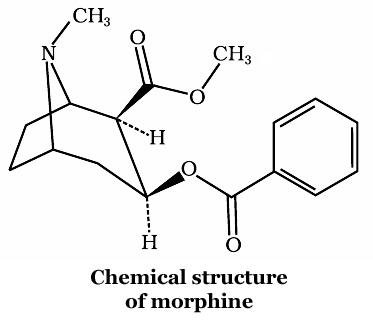
(ii) Codeine : A derivative of opium (methyl-morphine) which occurs naturally in opium and is partly converted in the body to morphine. It is mild analgesic; which do not cause addiction. It is an ingredient of many medicines and cough syrups. Its prominent side effect is constipation.
(iii) Heroin [Diamorphine or Diacetylmorphine] : Heroin also called as smack and is semisynthetic opiate which is addictive most dangerous of all the opiates. It is about 3 times more potent than morphine. Due to its high potency, it has been favoured in illicit drug trafficking, so it has been banned in most countries, Heroin is formed from morphine by acetylation. It is taken orally, or inhaled or injected, pure drug is seldom taken. It induces drowsiness and lethargy. Heroin causes indigestion, reduced vision, decreased weight, sterility and total loss of interest in work. Since the heroin addicts are careless about syringes and needles for injection so this may cause blood poisoning, abscess formation, hepatitis-S and AIDS. Withdrawal symptoms are unpleasant which include vomiting, diarrhoea, shivering, running nose, muscular and abdominal cramps and epilepsy.
(iv) Pethidine (Meperidine) : It is a synthetic opiate which is chemically unrelated to morphine but has many similar actions. Its analgesic efficiency is almost similar to morphine and is more than codeine. It is equally sedative and euphoriant. It causes less histamine release and is safer in asthmatics. It has local anaesthetic action. It is mostly metabolized in liver.
(v) Methadone: It is a synthetic opiate which is chemically dissimilar but pharmacologically very similar to morphine. It has analgesic, respiratory depressant, constipating actions similar to morphine. Withdrawal symptoms are gradual and less severe.
Concept Builder
Endorphins ("endogenous morphine") are endogenous opioid peptides that function as neurotransmitters.
They are produced by the pituitary gland and the hypothalamus in vertebrates during exercise, excitement, pain, consumption of spicy food and they resemble the opiates in their abilities to produce analgesia and a feeling of well-being.
The term "endorphin" implies a pharmacological activity (analogous to the activity of the corticosteroid category of biochemicals) as opposed to a specific chemical formulation.
It consists of two parts: endo and orphin, these are short forms of the words endogenous and morphine, intended to mean "a morphine-like substance originating from within the body.
3. Stimulants:
Drugs which stimulate the nervous system; make a person more wakeful, alert and active; and cause excitement.
However, addiction is psychological and withdrawal of stimulant is followed by depression, anxiety and restlessness. e.g., caffeine, cocaine, amphetamines etc.
(i) Caffeine:
It is bitter alkaloid; obtained from the leaves of tea plant, (Thea sinensis)-seeds of coffee plant, (Coftea arabica)-seeds of cocoa plant, (Theobroma cacao)-It is mild stimulant and taken as beverages-tea, coffee, cocoa and cola drinks.
Caffeine is CNS stimulant which provides a sense of wellbeing, alertness, beats boredome, thinking becomes clear, improves performance and also acts as cardiac and respiratory stimulant.
It is mild diuretic (increases urine output).
Caffeine increases contractile power of skeletal muscles.
BMR (Basal Metabolic Rate) and inhibits the release of histamine.
Higher doses of caffeine cause nervousness, restlessness, panic, insomnia (lack of sleep) and excitement.
Excessive intake of caffeine also causes addiction and indigestion and disturbs renal functions.
(ii) Cocaine:
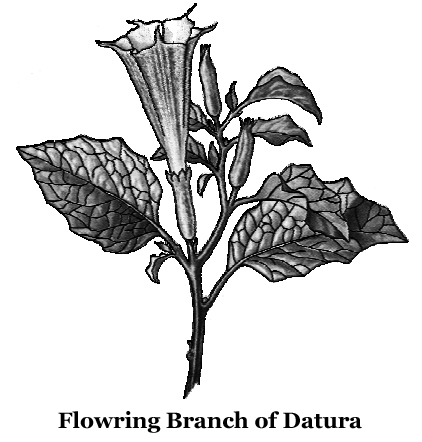
It is a natural alkaloid obtained from leaves of coca plant-Erythroxylum coca (Family; Erythroxylaceae).
It is bitter, white, crystalline powder with vasoconstrictor properties and hence, it is a good local anaesthetic.
It interferes with the transport of neuro-transmitter dopamine.
It is taken by snorting.
It is a powerful, CNS stimulant which induces a sense of wellbeing or euphoria and pleasure and delays fatigue.
It also increases heart beat, blood pressure and body temperature.
It is smoked or injected or inhaled by addicts.
It causes lack of sleep loss of appetite, headache, convulsions, insomnia, respiratory or cardiac failure and may lead to mental disorder.
Excessive dosage of cocaine causes hallucinations. Some other plants such as Atropa bellandona and Datura has hallucinogenic properties.
Concept Builder
The mechanism of action of cocaine:
Cocaine modifies the action of dopamine in the brain.
The dopamine rich areas of the brain are the ventral tegmental area, the nucleus accumbens and the caudate nucleus-these areas are collectively known as the brain's "reward pathway".
Cocaine binds to dopamine re-uptake transporters on the pre-synaptic membranes of dopaminergic neurons.
This binding inhibits the removal of dopamine from the synaptic cleft and its subsequent degradation by monoamine oxidase in the nerve terminal.
Dopamine remains in the synaptic cleft and is free to bind to its receptors on the post synaptic membrane, producing further nerve impulses.
This increased activation of the dopaminergic reward pathway leads to the feelings of euphoria and the 'high' associated with cocaine use.
(iii) Amphetamines:
They are synthetic drugs, commonly called pep pills, antisleep drugs or speed uppers because they are CNS stimulants.
They cause alertness, self-confidence, talkativeness and increased work capacity.
They stimulate respiratory centre and cause wakefulness and postponement of sleep and hence called antisleep drugs.
Due to slow metabolism, the drug is found in the urine for several subsequent days.
It is one of the drugs included in the 'dope test' for athletes, suppress hunger (anorexia) and cause addiction.
High doses of amphetamines produce euphoria, marked excitement, sleeplessness, nausea and vomiting.
4. Psychedelic Drugs (=Hallucinogens) :
The drugs which change one's mood, behaviour, thoughts and perceptions in a manner like that of seen in psychosis.
The hallucinogens generally produce a dreamlike state with disorientation and loss of contact with reality without any true sensory stimulus.
They cause hallucinations and usually make users to see sound and hear colour and also called vision producing drugs as they produce false imaginations or extreme feeling of either despair or euphoria by effecting cerebrum and sense organs.
Concept Builder
Hallucinogen :
A drug that causes hallucinations (profound distortions in a person's perceptions of reality).
Under the influence of hallucinogens, people see sound and hear colours and feel sensations that seem real but do not exist.
Some hallucinogens also produce rapid, intense emotional swings.
Hallucinogens cause their effects by disrupting the interaction of nerve cells and the neurotransmitter serotonin.
Distributed throughout the brain and spinal cord, the serotonin system is involved in the control of behavioral, perceptual, and regulatory systems, including mood, hunger, body temperature, sexual behavior, muscle control, and sensory perception.
(i) LSD (Lysergic acid diethylamide) : It is the most powerful psychedelic (=hallucinogen). It is a crystalline amidated alkaloid obtained from ergot, of fungus Claviceps purpurea that is parasite on rye plant. LSD was synthesized by Hofmann (1938). LSD causes horrible dreams, emotional outbursts, hallucination, chronic psychosis and severe damage to the central nervous system. LSD also brings about chromosomal and foetal abnormalities.
(ii) Mescaline: It is a white powdery alkaloid, obtained from the tops (called mescals) of a small spineless cactus, Lophophora williamsii. This cactus is also called 'Peyote cactus'. It is a low potency hallucinogen.
(iii) Psilocybin: It is obtained from the fruiting bodies of Mexican mushroom (fungus), Psilocybe mexicana (family: Agaricaceae). Psilocybin is a crystalline solid that may have value in psychological medicine. Its effects are similar to those of mescaline.
(iv) PCP (Phencyclidine piperidine) : It has stimulant, depressant, hallucinogenic and analgesic properties. Its higher dose may produce hypersalivation, vomiting, fever and even coma. It is widely used in veterinary medicine to briefly immobilize large animals.
Synthetic derivatives like DMT (Dimethyltryptamine), DOM (Dimethoxymethylamphetamine), DMA (Dimethoxyamphetamine) are also hallucinogenics.
(v) Products of Hemp plant: Known as 'Cannabinoids'. Tetrahydrocannabinol (THC) is present in hemp plant, Cannabis (family: Cannabinaceae) bhang, ganja, marijuana, etc., are the various forms in which THC is used as hallucinogen.
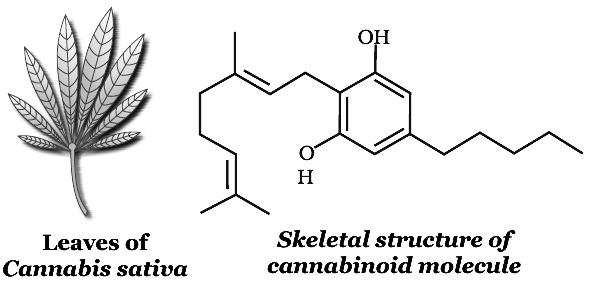
(a) Bhang: It is fresh/dried leaves and flowering shoots of both male and female plants of Cannabis sativa. Bhang is generally taken orally (e.g. , drink or in the form of pakora or tikki). It acts slowly.
(b) Ganja: It is the dried unfertilized female inflorescence of Cannabis sativa. It is smoked generally in cigarettes. It is more potent, and its effects are produced almost instantaneously.
(c) Charas: It is the dried resinous extract from the flowering tops and leaves of Cannabis sativa, which is most potent and smoked with tobacco. In some countries like America, charas is called hashish. Liquid hashish is called hash oil, which may contain a THC concentration of 25 to 60 percent.
(d) Marijuana: It is obtained from the dried flowers and top leaves of the female plants of Cannabis sativa, its most active ingredient is delta-9-tetrahydrocannabinol (Delta-9 THC). It is smoked in Cigarettes.
ALCOHOLISM
Alcoholism is a dependency of a person on regular consumption of alcohol either in low concentration (wine, bear etc.) or in high concentration (rum, vodka etc.)
Effects of Alcohol on an Individual
1. Effect on liver:
Absorbed alcohol is carried directly to the liver, where it becomes the preferred fuel.
Use of moderate amounts of alcohol does not cause liver damage, provided adequate nutrition is maintained.
However, chronic alcoholism causes the following diseases. (i) Alcoholic fatty liver. The liver becomes enlarged, yellow, greasy and firm. Hepatocytes (cells of liver) are distended by large fat globules which push the hepatocyte nucleus against the cell membrane. There is increase in the fat synthesis in the liver (ii) Alcoholic hepatitis. It is characterised by degeneration of hepatocytes. The damaged (degenerated) hepatocytes are surrounded by polymorphonuclear leucocytes. These hepatocytes may be pale and swollen and some contain dense eosinophilic masses called Mallory's hyaline. (iii) Alcoholic cirrhosis. With continued alcohol intake, there is destruction of hepatocytes and fibroblasts (cells which form fibres) and stimulation of collagen protein formation. (iv) Cholestasis (Gr. Chole -bile, stasis -a standing still). It is stoppage in the flow of bile. It is characterised by jaundice, abdominal pain and hepatomegaly (enlargement of liver).
2. Effect on nervous system : These are characterised as :
(i) Will power, judgement power and self control become reduced.
(ii) Control on emotion becomes reduced.
(iii) Moral sense becomes reduced.
(iv) Cerebellum becomes affected which results the loss of muscle co-ordination so affected person shows staggering gait and incoherent speech.
(v) Inflammation ofaxons of neurons leads to neuritis.
3. Effects on stomach :
High doses of alcohol cause ill effect on gastric glands of stomach, these glands secrete gastric juices in excess which cause the inflammation to gastric mucosa.
This condition is known as gastritis.
It may also result gastric carcinoma, peptic ulcer.
Dilute alcohol (optimum 10%) stimulates gastric secretion (specially acid).
Acute alcoholic intake can result in inflammation of the oesophagus (oesophagitis) and stomach (gastritis).
Chronic heavy drinking, if associated with violet vomiting, can produce a longitudinal tear in the mucosa at the gastrointestinal junction -a Mallory-Weiss syndrome (also called Mallory -weiss Lesion).
4. Effect on heart :
Due to deposition of alcoholic fat on the wall of blood vessels, the lumen of blood vessels becomes reduced, this increases the blood pressure and hence, the activity of heart.
Size of RBCs becomes increased but the number of RBCs, WBCs and platelets is reduced.
5. Effect on kidneys:
Alcohol reduces the release of hormone ADH (Antidiuretic hormone) due to which the excess amount of water is released from the body. So, alcoholism greatly causes dehydration condition.
6. Heavy drinking can cause an acute alcoholic myopathy characterized by painful and swollen muscles and high levels of serum creatine phosphokinase (CK).
7. Alcohol increases RBC size causing a mild anaemia. Chronic heavy drinking can also decrease production of white blood cells (WBCs). Alcohol may decrease platelet aggregation.
8. Effects on the skeletal system include alternations in calcium metabolism with an increased risk for fracture and osteonecrosis (death of bone mass) of the head of femur.
9. Hormonal changes include an increase in cortisol levels, inhibition of vasopressin, reversible decrease in serum thyroxine and a more marked decrease in serum triiodothyronine (T3).
10. Heavy drinking during pregnancy results in serious consequences for foetal development. The foetal alcohol syndrome (FAS) includes facial changes, poorly formed concha (cavity of pinna), small teeth with faulty enamel, defects in atria and ventricles of heart.
11. Regular intake of small to moderate amounts has been found to raise HDL -high density lipoproteins (good cholesterol) and lower LDL -low density lipoproteins (bad cholesterol) levels in the blood plasma. This may be responsible for lower incidence of coronary artery disease in such persons. Alcohol also reduces blood sugar level which is harmful to the functioning of brain.
12. Effect on immunity: Alcoholism reduces resistance to infection. The alcoholics in most cases, are victims of malnutrition and are easily susceptible to diseases like pneumonia.
13. Effect on family: The habit of drinking not only creates problems to the drinker but directly or indirectly affects the family and community life. Most drinkers do not think regarding needs of their children and other members of the family.
14. Effect on society: Alcoholism is invariably associated with social crimes and dissolution of moral and cultural inhibitions. Violence and other corrupt practices in the community are often directly or indirectly due to the drinking of alcohol.
Metabolism of Alcohol
In body the alcohol passes to the stomach.
Some amount of it also passes to proximal part of intestine.
Thus, stomach and proximal part of intestine absorb this alcohol and then transfer to blood and from blood to liver.
In liver, alcohol is converted to acetaldehyde with the help of enzyme alcohol dehydrogenase.
Acetaldehyde is oxidized by the enzyme acetaldehyde dehydrogenase.
It liberates the heat.
This heat is utilized in the synthesis of fat.
The excess of fat reduces the formation of glycogen, enzymes and structural proteins.
This condition is known as cirrhosis.
TOBACCO ADDICTION
Tobacco can be obtained from dried and cured leaves of young branches of two species of tobacco plant, Nicotiana tobaccum and N. rustica. Tobacco plant belongs to angiospermic family Solanaceae.
The use of tobacco was started in America where Red Indians were started use it. It spreads to Europe and other countries in early 1700s.
Table : Toxic substances of Tobacco and their effects
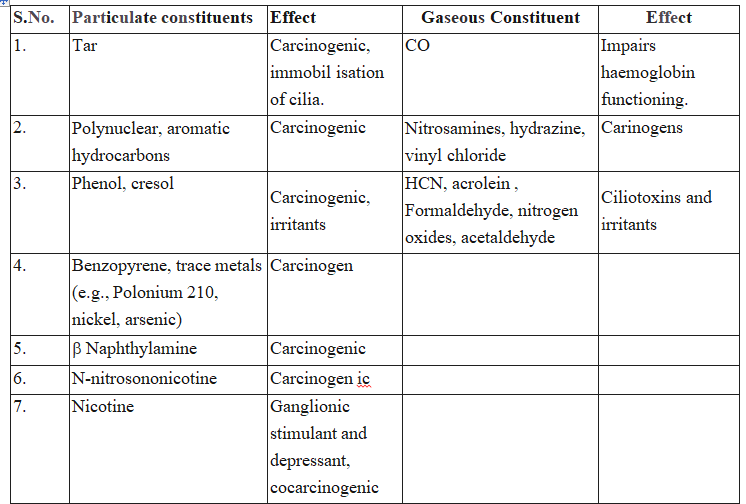
Tobacco Smoking and Diseases
1. Cancer: About 90% of victims of lung cancers are associated with smoking. Another cancer is mouth cancer due to chewing of tobacco.
2. Immunity becomes weak due to regular use of tobacco.
3. Use of tobacco increases the male infertility.
4. More adrenaline is released which increases blood pressure and heart rate. It may lead cardiovascular diseases.
5. In pregnant women, nicotine alkaloid reduces foetal growth and development.
6. Carbon monoxide present in smoke combines with haemoglobin present in blood and forms carboxyhaemoglobin. It greatly reduces the oxygen carrying capacity of blood.
7. Premature wrinkling may be possible.
8. It is also known to cause Pulmonary tuberculosis.
9. Smoking causes inflammation of lung alveoli which decreases surface area for gaseous exchange and cause emphysema.
10. Smoking causes irritation and inflammation of mucosa of throat and bronchi which causes coughing and bronchitis.
11. Smoking accelerates the secretion gastric juices which causes gastric and duodenal ulcers.
Drugs of abuse are frequently taken with alcohol or other common medicine e.g., aspirin, insulin. Such combination can lead to increased sedation or reduces the effect or medicine or complication like hypertension.
Table : Interaction of Alcohol and other Substances of Abuse with some Common Drugs
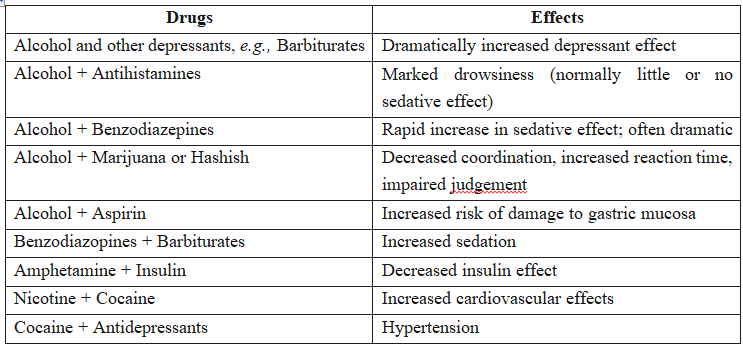
Drugs like barbiturates; amphetamines, benzodiazepines, lysergic acid diethyl amides (LSD), and other similar drugs, that are normally used as medicines to help patients cope with mental illnesses like depression and insomnia, are often abused.
Morphine is a very effective sedative and painkiller, and is very useful in patients who have undergone surgery.
Several plants, fruits and seeds having hallucinogenic properties have been used for hundreds of years in folk-medicine, religious ceremonies and rituals all over the globe.
When these are taken for a purpose other than medicinal use or in amounts/frequency that impairs one's physical, physiological or psychological functions, it constitutes drug abuse.
Drug abuse is found only with those who live a stressful life, unsatisfied with themselves, feel insecure.
As the problems and stress are becoming a part of modern life, these a person must learn to face the problems and stresses.
One must discuss the problems with family members/friends and attempt to sort them out, rather than to resort to drug/alcohol use.

 ACME SMART PUBLICATION
ACME SMART PUBLICATION
